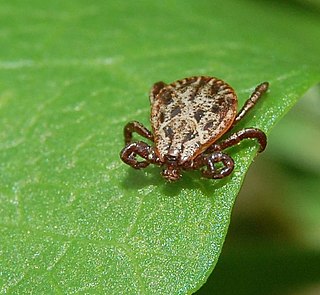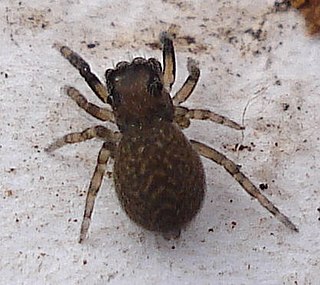
The reticulated python is a python species native to South and Southeast Asia. It is the world's longest snake, and listed as least concern on the IUCN Red List because of its wide distribution. In several countries in its range, it is hunted for its skin, for use in traditional medicine, and for sale as a pet.
The Furongian is the fourth and final epoch and series of the Cambrian. It lasted from 497 to 485.4 million years ago. It succeeds the Miaolingian series of the Cambrian and precedes the Lower Ordovician Tremadocian stage. It is subdivided into three stages: the Paibian, Jiangshanian and the unnamed 10th stage of the Cambrian.
Crotaphytus reticulatus, commonly called the reticulate collared lizard, is a species of moderately sized lizard in the family Crotaphytidae. The species is native to semiarid, rocky regions of the Tamaulipan mezquital. Its range includes the American state of Texas and the Mexican states of Coahuila, Nuevo León, and Tamaulipas. Of all the species in the family Crotaphytidae, C. reticulatus is the only species which is not restricted to rocky habitats.
The Paibian is the lowest stage of Furongian series of the Cambrian. It follows the Guzhangian and is succeeded by the Jiangshanian stage. The base is defined as the first appearance of the trilobite Glyptagnostus reticulatus around 497 million years ago. The top, or the base of the Jiangshanian is defined as the first appearance of the trilobite Agnostotes orientalis around 494 million years ago.

Boletus reticulatus, and commonly referred to as the summer cep is a basidiomycete fungus of the genus Boletus. It occurs in deciduous forests of Europe where it forms a symbiotic mycorrhizal relationship with species of oak (Quercus). The fungus produces fruiting bodies in the summer months which are edible and popularly collected. The summer cep was formally described by Jacob Christian Schäffer as Boletus reticulatus in 1774, which took precedence over B. aestivalis as described by Jean-Jacques Paulet in 1793.

Elaeocarpus reticulatus, commonly known as blueberry ash, ash quandong, blue olive berry, fairy petticoats, fringe tree, koda, lily of the valley tree and scrub ash, is species of flowering plant in the family Elaeocarpaceae and is endemic to eastern Australia. It is a shrub or small tree with a oblong to elliptic leaves, racemes of white or pink flowers and blue, oval to spherical fruit.

Orectolobus reticulates, the network wobbegong, is a recently described species of carpet shark found in relatively shallow waters off Kimberley and Darwin in north-western Australia. With a known maximum length of only 52.3 centimetres (20.6 in), it may be the smallest species of wobbegong. Until its description in 2008, it had been confused with the northern wobbegong.

Oreaster reticulatus, commonly known as the red cushion sea star or the West Indian sea star, is a species of marine invertebrate, a starfish in the family Oreasteridae. It is found in shallow water in the western Atlantic Ocean and the Caribbean Sea.
Sessiluncus abalaae is a species of mite in the family Ologamasidae.
Sessiluncus aegypticus is a species of mite in the family Ologamasidae.
Sessiluncus bengalensis is a species of mite in the family Ologamasidae.
Sessiluncus calcuttaensis is a species of mite in the family Ologamasidae.
Sessiluncus femoralis is a species of mite in the family Ologamasidae.
Sessiluncus leei is a species of mite in the family Ologamasidae.

Glyptagnostus reticulatus is a species of agnostid trilobite belonging to the genus Glyptagnostus. It existed during the Paibian Age of the Cambrian. It has a cosmopolitan distribution and is an important index fossil in biostratigraphy. It was characterized by an unusual net-like pattern of furrows on both the cephalon and the pygidium.

Malayopython is a genus of constricting snakes in the family Pythonidae. The genus is native to India and Southeast Asia. It contains two species, both of which were previously classified within the genus Python. However, multiple studies recovered these species as distinct. Known as the "reticulatus clade", it was eventually found to be a sister lineage to a lineage giving rise to the Indo-Australian pythons rather than the genus Python.
Stenocarpus reticulatus, commonly known as black silky oak, is a tree of the family Proteaceae native to the Queensland.

Dermacentor reticulatus, also known as the ornate cow tick, ornate dog tick, meadow tick, and marsh tick, is a species of tick from the family Ixodidae. It is the type species for the genus Dermacentor. D. reticulatus is an ornate tick. The female varies in size from 3.8–4.2 mm (unfed) to 10 mm when engorged after feeding. The unfed male is 4.2–4.8 mm long. D. reticulatus is found in Europe and Western Asia, generally in wooded areas.

Phyllanthus reticulatus is a plant species described Jean Louis Marie Poiret; it is included in the family Phyllanthaceae.

Neon reticulatus is a species of jumping spider in the family Salticidae. It is found in North America, Europe, Turkey, Caucasus, a range from Russia (European to the Far East, Kazakhstan, Korea, and Japan.








